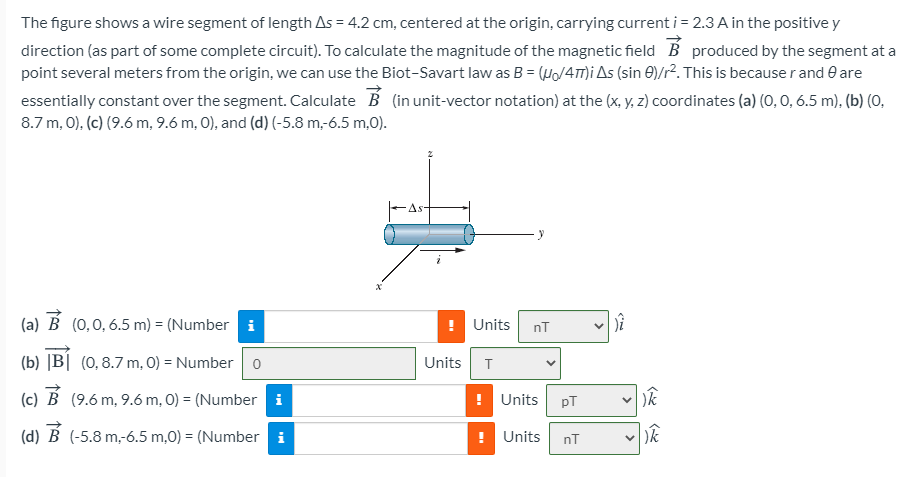The figure shows a wire segment of length As = 4.2 cm, centered at the origin, carrying o direction (as part of some complete circuit). To calculate the magnitude of the magnetic point several meters from the origin, we can use the Biot-Savart law as B = (Ho/4TT)i As ( essentially constant over the segment. Calculate B (in unit-vector notation) at the (x,
The figure shows a wire segment of length As = 4.2 cm, centered at the origin, carrying o direction (as part of some complete circuit). To calculate the magnitude of the magnetic point several meters from the origin, we can use the Biot-Savart law as B = (Ho/4TT)i As ( essentially constant over the segment. Calculate B (in unit-vector notation) at the (x,
Principles of Physics: A Calculus-Based Text
5th Edition
ISBN:9781133104261
Author:Raymond A. Serway, John W. Jewett
Publisher:Raymond A. Serway, John W. Jewett
Chapter22: Magnetic Forces And Magnetic Fields
Section: Chapter Questions
Problem 63P
Related questions
Question
100%
PLEASE be clear in your answer since the last time I posted was incorrect, thanks.

Transcribed Image Text:The figure shows a wire segment of length As = 4.2 cm, centered at the origin, carrying current i = 2.3 A in the positive y
direction (as part of some complete circuit). To calculate the magnitude of the magnetic field B produced by the segment at a
point several meters from the origin, we can use the Biot-Savart law as B = (Ho/4m)I As (sin E)/r². This is because r and e are
essentially constant over the segment. Calculate B (in unit-vector notation) at the (x, y, z) coordinates (a) (0, 0, 6.5 m), (b) (0,
8.7 m, 0), (c) (9.6 m, 9.6 m, 0), and (d) (-5.8 m,-6.5 m,0).
As-
(a) B (0,0,6.5 m) = (Number i
Units
nT
(b) |B| (0,8.7 m, 0) = Number o
Units
T
(c) B (9.6 m, 9.6 m, 0) = (Number i
! Units
pT
(d)
(-5.8 m,-6.5 m,0) = (Number i
! Units
nT
v )k
>
Expert Solution
This question has been solved!
Explore an expertly crafted, step-by-step solution for a thorough understanding of key concepts.
This is a popular solution!
Trending now
This is a popular solution!
Step by step
Solved in 3 steps

Recommended textbooks for you

Principles of Physics: A Calculus-Based Text
Physics
ISBN:
9781133104261
Author:
Raymond A. Serway, John W. Jewett
Publisher:
Cengage Learning

Physics for Scientists and Engineers: Foundations…
Physics
ISBN:
9781133939146
Author:
Katz, Debora M.
Publisher:
Cengage Learning


Principles of Physics: A Calculus-Based Text
Physics
ISBN:
9781133104261
Author:
Raymond A. Serway, John W. Jewett
Publisher:
Cengage Learning

Physics for Scientists and Engineers: Foundations…
Physics
ISBN:
9781133939146
Author:
Katz, Debora M.
Publisher:
Cengage Learning


Physics for Scientists and Engineers with Modern …
Physics
ISBN:
9781337553292
Author:
Raymond A. Serway, John W. Jewett
Publisher:
Cengage Learning

Physics for Scientists and Engineers
Physics
ISBN:
9781337553278
Author:
Raymond A. Serway, John W. Jewett
Publisher:
Cengage Learning

Physics for Scientists and Engineers, Technology …
Physics
ISBN:
9781305116399
Author:
Raymond A. Serway, John W. Jewett
Publisher:
Cengage Learning